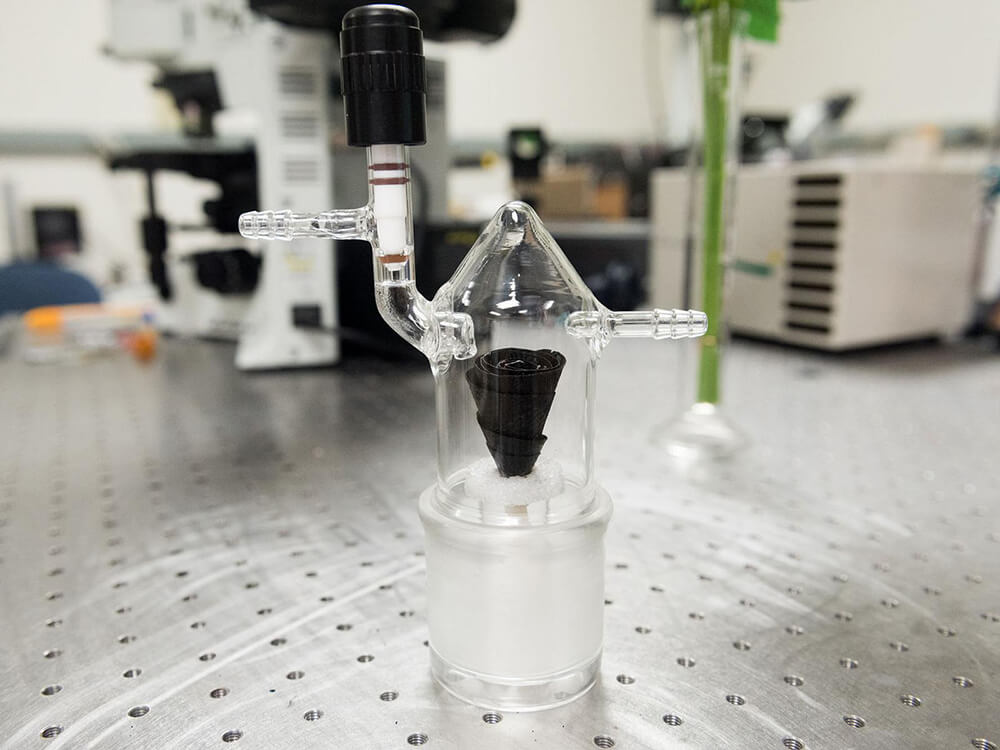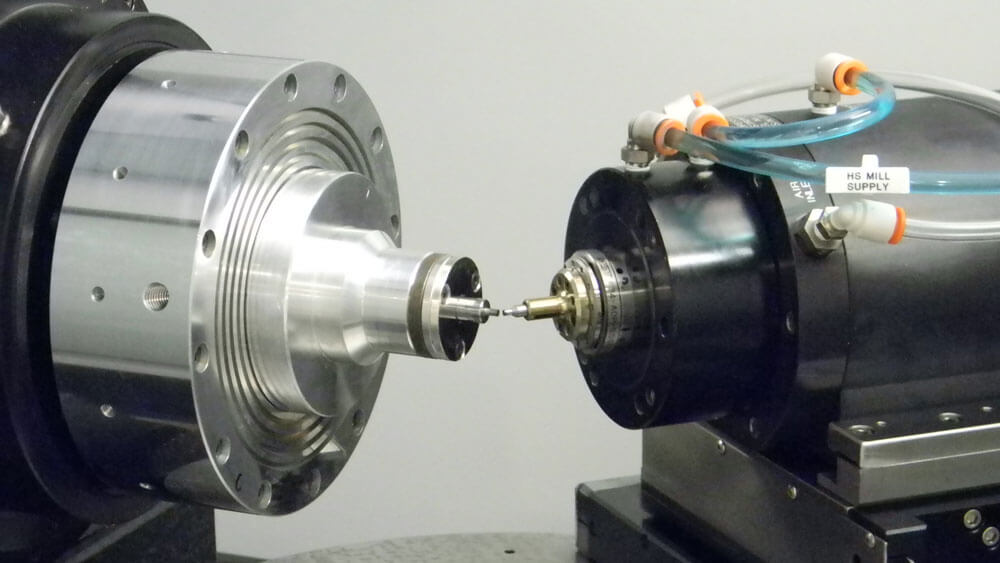Developing Nano Machining in the Defense Industry
To imagine the scale at which nano machining technology works, consider this. A baseball bat is one meter long, divided by ten, equals the length of a pen, and divided by ten again, equals the width of a finger.
One-tenth of that is a millimeter, which is about the size of the eye of a pin. Divide by ten, and you get 100 micrometers—about the width of a human hair. That’s about the smallest size the human eye can see. Divide that distance by ten, and you get the size of a red blood cell. Divide by ten again, and you get the diameter of a single bacterium, which is just 1 micrometer.
One-tenth of that size is 100 nanometers, which is the size of a single virus and the largest size at which nano machining technology can operate. To get to the size of a single nanometer, you’d have to examine one-hundredth the size of a virus to see a single DNA strand.
To put it in perspective, imagine an ant on a racetrack. A nanometer is to the ant what an ant is to the racetrack.
Nano machining technology is so small, yet so impactful. That’s because at this scale, strange things start to happen. Physical forces that have no power in our world become powerful at the nanoscale. Matter behaves differently, and materials take on new physical and chemical properties.
For example, traditional gold is yellow or white. But at the nanoscale, it can be purple, red, or blue. At our scale, gravity is the defining force for everything in the macroscopic world, but for individual nanoparticles, gravity is negligible because nanoparticles are more affected by Brownian motion or turbulent diffusion.

1.Basics of Nanomaterials
Researchers in nano machining technology study the physical laws that govern this tiny world and can use them to our benefit.
They can now manipulate nanoparticles to align in specific ways, change how they react to other materials, or change their inherent properties to get something new.
When these nanoparticles are dispersed in another material to form a composite material, they can affect the overall functionality of the composite.
For example, a polymer may lack conductivity, but by mixing in a small amount of nanoparticles that conduct electricity well, the polymer can become conductive. And vice versa, depending on the need.
Properties that can be added or removed include:
· Chemical resistance
· Electromagnetic properties
· Thermal conductivity
· Abrasion resistance
· Electrical conductivity
· Mechanical strength
· Antimicrobial properties
· UV protection
This can be achieved without losing any of the original properties of the polymer, as nanomaterials represent an extremely low percentage of the total weight/volume.
This is because their tiny size gives them a huge surface area to weight ratio, meaning that 0.2 wt.% of nanoadditives can be effective.
Nanoadditives are most commonly applied to materials such as polyester or epoxy resins, polycarbonates, silicone-based materials, methyl methacrylate, phenol formaldehyde resins, and even gypsum-based materials.
If it is not possible to use nanomaterials to create new composites, coatings containing nanoadditives can be used to give surfaces specific properties – often providing a protective barrier against abrasion, chemicals, UV rays, or bacteria and viruses.
For manufacturers, this means that nanomaterials can provide unique selling points, such as additional strength or conductivity, with little to no increase in raw material input costs.
Alternatively, nanomaterials can reduce costs by replacing other raw materials that are more expensive or replacing them in smaller quantities.
This practice has been widely adopted by the automotive industry, which previously made almost all engine parts from metal parts. They did this because metal is strong, but also heavy. Switching to lightweight aluminum would reduce the load, but increase costs.
Today, polymers can be reinforced with nano additives, providing an alternative that is strong enough but lighter.
Elsewhere in the engine, rubber hoses are used to transport lubricants or fuel. However, rubber is susceptible to chemical corrosion, thermal stress, and easily wears due to friction.
Nanomaterial additives can limit these effects, while also having antistatic properties to reduce the risk of fire or explosion.
In this way, nanomaterials can make modern cars and trucks more fuel-efficient and safer to drive.
Compared to traditional raw materials, nanomaterials are smaller in size, but also lighter, cheaper and smarter. This is why nanomaterials are often seen as the future of raw materials.

2.Development of nano machining technology in the defense industry
The defense industry is always innovating. Wars are often won by the side with the greatest technological advantage. Therefore, nanomachining technology is a focus of defense industry research.
Breakthroughs in nanomaterials have changed the way buildings are heated, the way we communicate, the clothes we wear, the way we grow food and feed animals, the way we build, the way we travel, and the way wars are fought.
1) Nanomaterial-enhanced combat clothing
· Nanoengineered sensors for detecting biological and chemical agents.
· Energy-absorbing materials that protect against explosions or bullets.
· Ultra-low-weight armor with the flexibility of Lycra.
· Nanosensors that track a soldier’s heart rate and blood pressure. Built-in transmitters help medical evacuation teams find injured people on the battlefield for evacuation or on-site assistance to medical personnel.
2) Nanomaterial-enhanced explosives
With the application of nanomaterials in ballistics, we will be able to pack a certain amount of nanopowder into a smaller projectile, thereby increasing the range and enhancing the explosive power.
Nanomaterials can also provide advanced structural properties for missile and artillery shells, improve armor penetration and enhance the destructive power of bunker-buster bombs.
Nano machining could even allow one to build a “mini-nuke” that weighs only a kilogram or two but has the explosive power of 100 tons of TNT.
3.Other military applications of nano machining
Incorporating fiber-reinforced nanomaterials can help reduce overheating of moving parts and projectiles and increase the strength and ductility of military hardware components.
Soldiers and vehicles will soon be equipped with tiny antennas that can be embedded in soldiers’ uniforms, interweaving nanomaterials into textiles, or mixing nanomaterials directly into metals, rubbers or plastics. This
will enable tags with long-range identification, acoustic arrays, miniature GPS receivers and wireless connectivity to enhance communications. Battlefield commanders will know the precise location of each soldier or piece of equipment in real time.
Nano machining will also create solid oxide fuel cells that can produce more energy than traditional fuels. Nanoparticles can also be added to fuels to make jet fighters, tanks and ships faster, fly longer and operate at a wider range. These capabilities are valuable in the commercial automotive and aerospace industries.

4.The impact of nano machining on defense systems
Developing any future weapon requires pushing boundaries. For example, after the advent of biological and chemical weapons, international law prohibited the use of these weapons. Nano machining technology has been used to develop sensors that can detect chemical and biological weapons. Nano devices can also be used to detect and even reduce radioactivity.
Similarly, the future application of nano machining technology in certain defense fields may also be seen as unethical or may simply tip the balance of power by creating super weapons or disabling the weapons of opponents. Therefore, defense manufacturers may need to be wary of ethical restrictions and the power of the international community.
That being said, the secrecy behind military research, especially nano machining technology, is so high that enforcing such legislation may be impossible.

5.Nano machining technology breaks barriers
The scope and capabilities of nano machining technology are so great that it is difficult to know exactly where it will develop or what kind of power future weapons will have.
The key is that nano materials can create weapons that are more destructive than thermonuclear war. Even if this is avoided, nano machining technology in defense systems may still undermine the peace and cohesion of the international system.
Nano machining technology will also show the same trend as previous new technologies, which may lead to so-called nano wars, a new era of destruction. Therefore, anyone in the defense industry needs to consider this.
